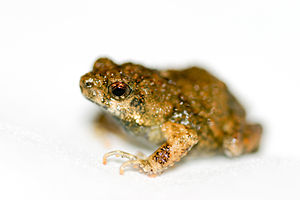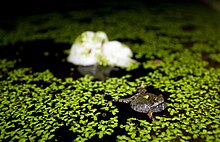Tungara frog
| Tungara frog | ||||||||||||
|---|---|---|---|---|---|---|---|---|---|---|---|---|

Tungara frog |
||||||||||||
| Systematics | ||||||||||||
|
||||||||||||
| Scientific name | ||||||||||||
| Engystomops pustulosus | ||||||||||||
| ( Cope , 1864) |
The Tungara frog ( Engystomops pustulosus , Syn .: Physalaemus pustulosus ), also known as the eyeball nodule, is a frog from the subfamily Leiuperinae within the family Leptodactylidae .
features
The males are up to 3 inches long, the females are slightly larger. The warty skin shows various shades of brown, from sand to dark brown to olive green. The numerous pustules and warts give the Tungara frog the appearance of a toad and have led to the species name pustulosus (warty). They can be arranged lengthways on the back or zigzag. In most cases, they are distributed irregularly on the skin. There are also small warts on the tympanum .
The Tungara frogs have no teeth on their jawbones. The first finger is longer than the second in this type.
distribution
The main distribution area of the Tungara frog is in South and Central America . It extends from the Orinoco in the south to Mexico in the north and includes Belize , Venezuela , Colombia , Panama , Costa Rica , Nicaragua , El Salvador , Honduras , Guatemala , Mexico and the islands of Trinidad and Tobago .
The Central American range was settled from South America ten to six million years ago, when there was no land bridge between the two American continents. Due to the biogeographical separation, two genetically different groups developed allopatrically , but they cannot be regarded as separate species. After the completion of the land bridge around three million years ago, there was again a mixing of the two groups in Panama and Costa Rica, which was proven by molecular genetic studies on frogs from western Panama and northwestern Costa Rica. Due to ice age events, however, there were repeated interruptions and gaps in the distribution area later on.
The frog is found mainly in the lowlands. This also includes subtropical and tropical savannahs as well as seasonally moist or flooded grasslands, marshland and pastures as well as open or degraded forests with ditches and ponds.
Way of life
The advertising behavior of some species and the reactions of the females to the calls of the males during the mating season were examined in detail. The males call out from the water at night, the sequence of sounds is very complex.
During mating in the water, the female releases a protein-containing secretion , which is whipped into a foam by the male. This foam nest accommodates the fertilized eggs until the tadpoles hatch . It ensures the survival of the brood in the event of drought. Various proteins in the foam protect the eggs from drying out and direct sunlight as well as from parasite infestation. The tadpoles usually hatch after four days, but the foam can function for up to two weeks if development is delayed.
The protein ranaspumin-2 from the foam can be used as a carrier substance to initiate artificial photosynthesis outside of cells. This new method of generating energy won the Earth Award in 2011.
Danger
The tungara frog is very common in northern South America and Central America. It occurs less frequently in the southwest of the Mexican state of Campeche and in Belize. Occurrences in Guyana are likely but not officially confirmed. Because of their abundance and wide range, the frog populations are considered stable and not endangered by the IUCN .
Taxonomy and systematics
The tungara frog ( Engystomops pustulosus ) belonged for a long time to the genus of the eyelid frogs ( Physalaemus ) and in 2005 it was spun off as a separate genus together with the other species of the Physalaemus pustulosus group. This was given the name Engystomops after a genus described by Jiménez-de-la-Espada in 1872 , to which at that time only the species Engystomops petersi , which was closely related to the Tungara frog , belonged until it was incorporated into the genus Physalaemus in 1970 .
In 2006, the large group of southern frogs (family Leptodactylidae in the broader sense) was divided into different, partly newly established families. Together with other genera, Engystomops was placed in the Leiuperidae family, which was later reintegrated as a subfamily into the whistling frog family (family Leptodactylidae in the narrower sense).
Individual evidence
- ↑ Engystomops pustulosus in amphibial web
- ↑ LA Weigt, AJ Crawford, AS Rand and MJ Ryan: Biogeography of the túngara frog, Physalaemus pustulosus: a molecular perspective. Mol Ecol., 12, pp. 3857-3876, 2005
- ↑ Heike Pröhl, Santiago R. Ron, Michael J. Ryan: Ecological and genetic divergence between two lineages of middle American túngara frogs Physalaemus (= Engystomops) pustulosus. BMC Evolutionary Biology, 10, p. 146, 2010 doi : 10.1186 / 1471-2148-10-146
- ↑ M. Ryan: The Túngara Frog: A Study in Sexual Selection and Communication. University of Chicago Press, Chicago 1992
- ↑ L. Dalgetty and Malcolm W. Kennedy: Building a home from foam - túngara frog foam nest architecture and three-phase construction process. Biology Letters, 6, pp. 293-296, Royal Society Publishing, 2010
- ↑ RI Fleming, CD Mackenzie u. a .: Foam nest components of the tungara frog: a cocktail of proteins conferring physical and biological resilience. In: Proceedings of the Royal Society B: Biological Sciences. 276, 2009, p. 1787, doi : 10.1098 / rspb.2008.1939 .
- ↑ David Wendell, Jacob Todd and Carlo Montemagno: Artificial Photosynthesis in Ranaspumin-2 Based Foam. Nano Letters, 10, 9, pp. 3231–3236, American Chemical Society, 2010 doi : 10.1021 / nl100550k ( PDF, English ( Memento of the original from July 16, 2011 in the Internet Archive ) Info: The archive link was inserted automatically and not yet Checked. Please check the original and archive link according to the instructions and then remove this note. )
- ↑ Georgina Santos-Barrera, Frank Solís, Roberto Ibáñez, Larry David Wilson, Jay Savage, Federico Bolaños, Julian Lee, Gerardo Chaves, Celsa Señaris, Andrés Acosta-Galvis, Jerry Hardy: Physalaemus pustulosus , IUCN Red List of Threatened Species, version 2010.4, IUCN 2010, accessed November 8, 2010
- ↑ Santiago R. Ron, JC Santos and DC Catanella: Phylogeny of the túngara frog genus Engystomops (= Physalaemus pustulosus species group; Anura: Leptodactylidae). Molecular Phylogenetics and Evolution, 39, 2, pp. 392–403, 2006 full text ( memento of the original dated December 2, 2008 in the Internet Archive ) Info: The archive link has been inserted automatically and has not yet been checked. Please check the original and archive link according to the instructions and then remove this notice. (PDF, English)
- ↑ LB Nascimento, U. Caramaschi, CAG Cruz: Taxonomic review of the species groups of the genus Physalaemus Fitzinger, 1826 with revalidation of the genera Engystomops Jiménez-de-la-Espada, 1872 and Eupemphix Steindachner, 1863 (Amphibia, Anura, Leptodactylidae ). Arquivos do Museu Nacional Rio de Janeiro, 63, 2, pp. 297-320, 2005
- ↑ TD Grant, DR Frost, JP Caldwell, R. Gagliardo, CFB Haddad, PJR Kok, BD Means, BP Noonan, W. Schargel and WC Wheeler: Phylogenetic systematics of dart-poison frogs and their relatives (Anura: Athesphatanura: Dendrobatidae) . Bulletin of the American Museum of Natural History, 299, pp. 1-262, 2006
Web links
- Georgina Santos-Barrera, Frank Solís, Roberto Ibáñez, Larry David Wilson, Jay Savage, Federico Bolaños, Julian Lee, Gerardo Chaves, Celsa Señaris, Andrés Acosta-Galvis, Jerry Hardy: Physalaemus pustulosus , IUCN Red List of Threatened Species, Version 2010.4 , IUCN 2010, accessed November 8, 2010
- Engystomops pustulosus from Amphibiaweb, accessed July 15, 2020.

